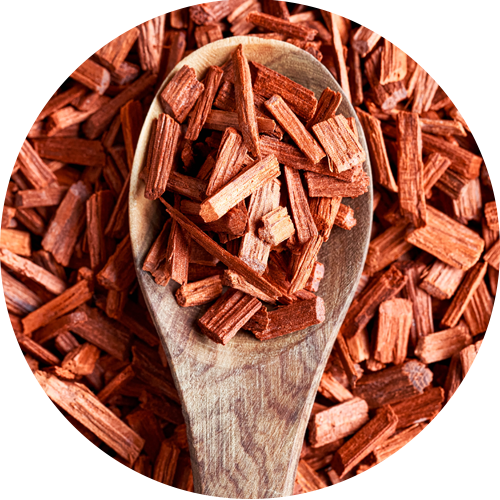Sandalwood, with its woody, milky and creamy profile, is essential to any perfumer’s palette, as it forms the base note of countless fragrance compositions.
Sandalwood is a richly fragrant evergreen tree. There are many varieties, but only a few are used in the world of perfumery: Santalum album, Santalum spicatu and Santalum australedonicum. The essential oil is obtained through the distillation of dried bark and roots. The best quality oil was previously obtained from the Indian Mysore variety, which today is protected as an endangered species. For this reason, Australian sandalwood and New Caledonian sandalwood are currently used.
It belongs to the botanical family Santalaceae, and its name has its origin in the Sanskrit word “Chandana”, meaning “pleasant to the senses”. This reflects the essence of sandalwood, famous for its captivating and pleasant smell. The olfactory appeal of sandalwood has made it a highly prized ingredient in perfumery, where its intoxicating aroma adds depth and sophistication to countless creations.
Its history dates back to Egypt, where it was used in embalming practices, as well as in the manufacture of furniture and for decorating luxurious temples. In Hinduism and Buddhism, it is revered and considered sacred, and was used in rituals aimed at alleviating the suffering of humanity. According to Hindu mythology, in the garden of the gods grows a wonderfully scented tree called “Hari Chandan”, of which the sandalwood was its “earthly trace”: literally, a divine tree.
Sandalwood has traditionally been associated with masculine fragrances. However, its use has increasingly extended to feminine fragrances as well, in order to add a woody note or to intensify other base notes.
Sandalwood can be used as a top note, and is most often found in woody, oriental or fougère fragrances. Its versatility allows it to be combined with all olfactory families, achieving different effects. It harmonizes with seductive notes such as rose, ylang-ylang and magnolia, providing a creamy and woody base to the delicate flowers; with citrus notes, it adds a touch of freshness and creates a vibrant accord; and with aromatic herbs, it evokes a relaxing and solid experience. Additionally, sandalwood enhances gourmand fragrances with its creamy and nutty notes.
The versatility of sandalwood inspires perfumers to create the best combinations of diverse and captivating scents that leave a lasting impression. We invite you to discover the multiple fragrance profiles with sandalwood notes that we have developed at @CramerLatam, which give character and delicacy to each fragrance.
You can also find us on






